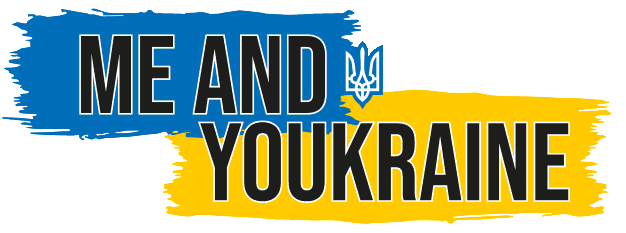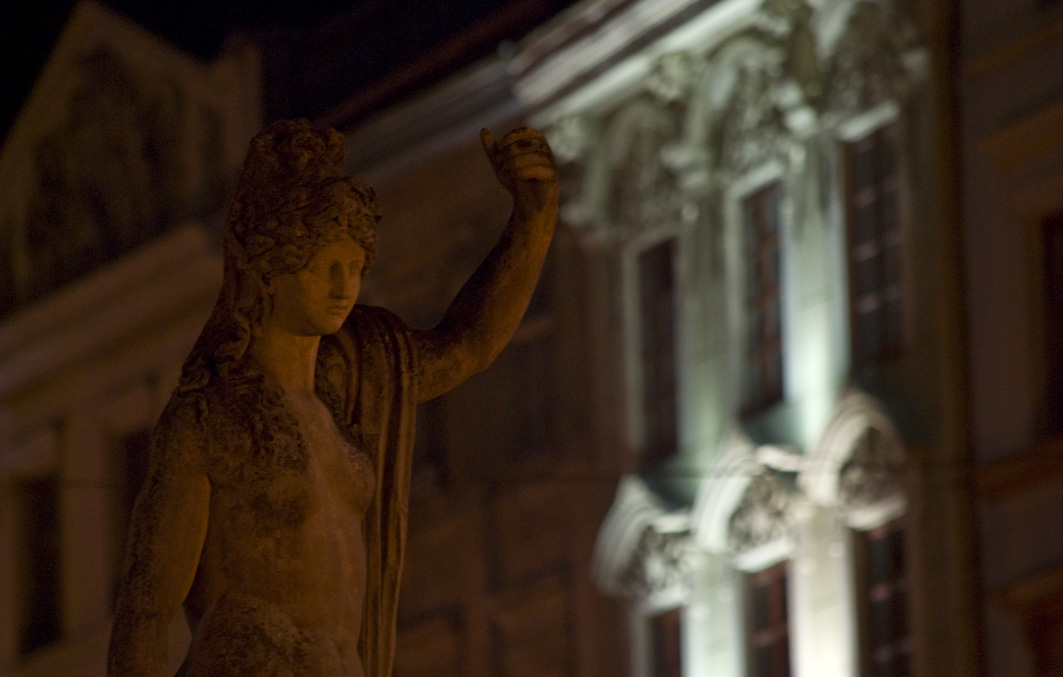
Andrey Sheptytsky National Museum
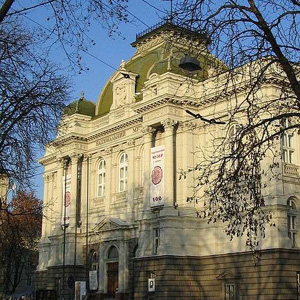
Being one of the most important museums of national art and cultural treasures, this museum was founded by Metropolitan Andrey Sheptytsky in 1905. The collections in the museum hold more than 140,000 unique items.
The museum takes special pride in presenting the largest and most complete collection of medieval sacral art of the 16th-18th centuries: icons, manuscripts, rare ancient books, decoratively carved pieces of art, metal and plastic artworks, and fabrics embroidered with gold and silver. The museum also boasts a unique monument of Ukrainian Baroque: the Bohorodchansky Iconostasis. Exhibits include:
- Ancient Ukrainian art from the 12th-15th centuries;
- Ukrainian art from the 16th – 18th centuries;
- Ukrainian art from the end of the 18th – beginning of the 20th century.
The museum, at 42 Drahomanova Street, houses the expositions of modern Ukrainian art. They demonstrate the wide range of prominent masters, who were at the vanguard of culture and art in the early 20th century. The exposition opens with the works by Trush, Novakivsky, Kulchytska and Parashchuk, which fully reflect the recent aesthetic searches of the European culture at the beginning of the last century.
The 20-year interbellum is widely represented in the exposition by works of well-known Ukrainian artists including the Selsky spouses, Monastyrsky, Krychevsky, Muzyka and Moroz. The next sections of the exposition represent post-war art, including Socialist Realism and the painters of the 60s. The latter’s height of creative activity coincided, on one hand with the period of so-called 'thaw', and on the other hand with strict censorship and persecution by the totalitarian system. The collection is supplemented by modern works of Lviv artists in the late 20th century.
20 Svobody Avenue, 42 Drahomanova Street
Tel. number: +38 032 235 88 56
nmlkult@gmail.com, museuminlviv@gmail.com
Opening hours: 10.00 – 18.00, Tue – Sun
Beer Brewing Museum
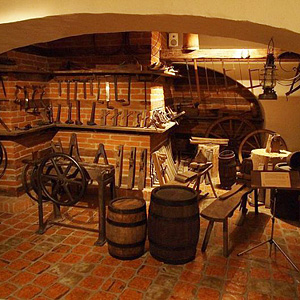
The Lviv Beer Brewing Museum is the first of its kind in Ukraine; it was opened on October 14th, 2005. The museum is located in the semi-basement premises of the Lviv Beer Plant and occupies a space of 600 square meters. The exhibition presents a complete history of beer brewing in Lviv and the Lviv Beer Plant. Here, you can view authentic tools and instruments used by brewers, collections of beer barrels and bottles, advertising and publicity samples, etc.
Our guests can also enjoy watching a video about the Lviv Beer Plant and visit our tasting hall, where our best samples of ‘Lvivske’ beer will more than please all beer lovers.
18 Kleparivska Street
Tel. number: +38 032 294-80-65
lvivbeermuseum@carlsberg.ua
www.lvivbeermuseum.com
Opening hours: 10.30 – 18.00, Wed – Mon
Interactive Museum 'Secret Pharmacy'
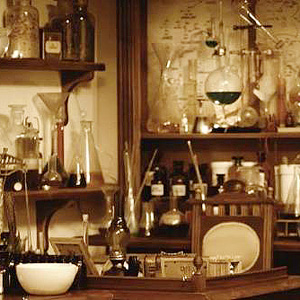
'Secret pharmacy' is the first interactive museum-pharmacy in Lviv. It is a 'secret' basement under one of the oldest pharmacy in Lviv: pharmacy 'Under the Hungarian crown'. Four reasons why you should visit the Secret pharmacy: 1. The amazing story of the last Alchemist; 2. Surprising facts about great inventions of pharmacists; 3. Exclusive happy pills: wholesale and retail; 4. Lion-pharmacist and other unique gifts of secret Lviv masters.
At the Secret Pharmacy you can watch a film about the history of the pharmacy. Our pharmacy is secret, so the drugs here are also unusual. Did you know that there are pills against boring work, love pills, pills against envy and happy pills? There is also a soap designed not only to clean the body, but also to cleanse thoughts and wash away bad consequences. Ask the pharmacist about it!
Now, the main pharmacy secret is protected by the only one Lion-pharmacist in the world. He will crush all your problems into powder in his mortar! If you want to know more – please visit our museum.
Pharmacy 'Under the Hungarian crown' was founded in 1772 at the former Bernardine Square (now Soborna Square) by the Alexander Lonshan de Ber’ye. This name was given, because in the Bernardine monastery for some time the relics of St. Stephen (king and patron saint of Hungary) were kept. At the beginning of the 20th century a new three storey building was built by architect Karol Boublik in the same place. The pharmacy is there today.
1 Soborna Square
Tel. number: +38 067 370 56 98
www.secret.lviv.ua
Opening hours: 10:00-20:00, seven days a week
Tours are conducted every hour (appointment only)
Ivan Franko Literary and Memorial Museum
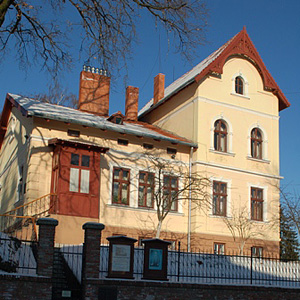
There are 26 thousand exhibits in the museum's collection. The most valuable of them are personal belongings of Ivan Franko and his family, the writer's manuscripts, signed first editions of his works and original photographs. For over sixty years people have been coming to this house, that is located in a picturesque place in Lviv near Stryisky Park. It was in this house, where the prominent writer, scientist, political and public figure wrote his best works. Ivan Franko's study – his favourite room – has been fully restored. The pianoforte Ivan Yakovych played, the table he worked at – they all have survived. Franko’s personal things lie on his desk: an inkwell with a pen, books, a Hutsul knife for cutting paper, a chandelier, a box for manuscripts, etc. Behind this desk the writer wrote hundreds of works including the poem 'Moses'. Next to the table beside the chair there is the fishing net that the writer made himself. Franko's bookcases stand full of books, while portraits and paintings by Ivan Trush – the writer's close friend – hang on the walls.
150-152 Franka Street
Tel. number: +38 032 276 44 16
Ivan Trush Artistic and Memorial Museum
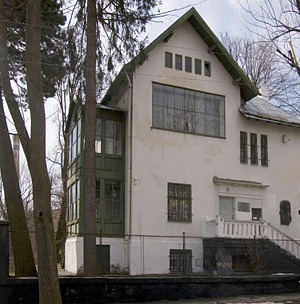
The exposition covers the life and creative work of the artist. The museum is situated in the villa built by Ivan in 1910, accordingly to the design of well-known architect Oleksandr Lushpynsky in Art Nouveau style. Here Ivan worked and lived for over thirty years, until 1941. The artist’s daughter Ariadna Trush bequeathed the mansion to the National Museum, wanting to establish an artistic and memorial museum.
Since its opening it has housed a permanent exposition consisting of two sections. The first section represents the multifaceted talent of Ivan Trush, covering various areas of artistic and social life of Halychyna at the turn of the 19th century. The collection of photographs and the epistolary legacy of the artist demonstrate his extraordinary personality, while a number of theoretical publications and reflections on pressing issues of cultural and artistic life show him as a critic and a public figure. The exposition’s second section exhibits the creative heritage of the artist, presenting him as an unsurpassed master of both lyrical landscape and psychological portrait as well as an author of many topical genre compositions.
28 Trusha Street
Tel. number: +38 (032) 237-04-63
Leopold Levytsky Artistic and Memorial Museum
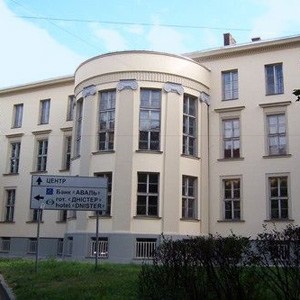
The Leopold Levytsky Museum was founded in 1984 and is situated in the building where he lived and worked from 1946 to 1973. The exposition is based on the peculiarities of the artist’s working environment; the flat’s interior, personal belongings and a part of the artistic heritage. The exposition consists of the memorial part and also represents the creative career of the artist from his time of studying at the Krakow Academy until the last days of his life.
Lviv National Museum possesses the largest collection of the artist’s works: over 6500 storage items, most of which were donated to the museum by his wife Henya: letters, manuscripts, documents, and other materials of inestimable value for studying the work and personality of Leopold Levytsky. She played the key role in the popularization of Levytsky’s name after his death. At the end of her life, she donated the artist’s creative heritage and his archive to the National Museum.
10 Ustiyanovycha Street
Tel. number: +38 032 261 06 10
Museum of Religious History
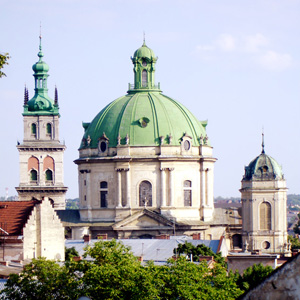
This museum is a cultural and spiritual institution, where the history of (inter)national religions and activities of various church organizations are displayed. Here, you can view unique collections and artifacts, which all represent important artistic and historical values. For example, the silver Byzantine reliquary from the 11th century, where the relics of Saint Aront the Martyr are preserved.
The museum is located in the Dominican Monastery, dating back to the 14th–18th centuries. Organ concerts are organized in the Dominican Church of the 18th century by the Services of Musical Enlightenment.
Spiritual excursions by night can be organized by reservation.
1 Musejna square
Tel. numbers: +38 032 235 60 32; +38 0322 235 61 00
religio@ukrpost.ua
www.museum.lviv.ua
Opening hours: 11.00 – 18.00, Tue – Sun
Lviv History Museum
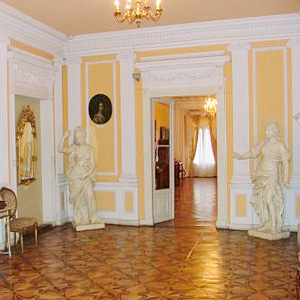
Lviv History Museum is one of the richest museums in Ukraine. Its collection counts up to approximately 300,000 pieces. The exposition of the Ancient and Medieval History Department includes exhibits of material and spiritual culture of Prykarpattya. Among the rarities there are encolpions – folding crosses intended for keeping parts of relics of saints. Weapons, signs of military honour and portraits of Ukrainian Hetmans painted in the 18th century tell about the heroic history of the Ukrainian Cossacks. The collection of Lviv Mint’s coins are displayed in exhibits of the 14th-17th centuries.
Books exhibited in the museum, including those printed by the first Ukrainian printer Ivan Fedorov, testify to the wealth and originality of Lviv’s culture. Some of the most prominent paintings in the world can also be found here, including a collection of coffin portraits which is exceptionally valuable, both from the historical and artistic point of view.
You can also see a collection of jewellery from many European countries: highly artistic items, adorned with precious stones, for both secular and religious purposes. The signet ring made by a German craftsman in the 17th century is especially impressive in its originality; it was used by magicians to communicate with the other world. Historical valuables (furniture, paintings and clocks) emphasize the exquisiteness of the Royal Halls’ interior.
Five thousand exhibits of cold arms and firearms from over thirty countries can be viewed in the Arsenal Museum at 5 Pidvalna St, which also houses an exhibition of religious-purpose items.
2, 4, 6 and 24 Rynok Square, 5 Pidvalna Street
Tel. number: +38 032 272 70 60
www.lhm.lviv.ua
Opening hours: 10 a.m. – 6 p.m. (until 5 p.m. during winter) daily except Wednesdays
Museum Literary Lviv
Department of Lviv History Museum
Exposition of Lviv Historical Museum 'Literary Lviv in the 1st half of the 20th century' was opened in autumn 1992. It is housed at five-room apartment built in 1937-1939 according to the design of Zygmunt Sperber. The aim of the museum is to show literary Lviv in the 20th century during the contradictions in politics and social conflicts, which were the background of this literature. On the territory of about 100 square meters cultural and literary life of the city during the late 19th/early 20th century is displayed. The exhibition creates a spiritual bridge from the past into our present. The museum shows original furniture, engravings, photographs, paintings, postcards and posters of contemporary city. The basis is funds from Lviv Historical Museum. The room is small, that only 15 visitors can enter at the same time. In an ordinary apartment literary and cultural life is reflected and at the same time the atmosphere of the house is retained. Interiors of the rooms reflect the feeling and spirit of that time.
Ukrainian modern 'molodomuzyvtsi', poetry of Sich riflemen, mutual influence of Galician and Upper Dnieper artists, forbidden works of repressed poets and writers, famous emigrated Ukrainians are examples of themes represented in the museum. The museum also operates as a kind of art salon. It is a meeting place for creative young people and intellectuals. It is the centre of national and cultural education of youth in the best traditions of Ukrainian culture.
18 Hvardiyska Street
Tel. number: +38 032 238 62 07
www.lhm.lviv.ua
Department of Liberation Struggle

Exhibition of the Ukrainian Department of Liberation Struggle ‘Military and Historical Monuments’ features materials on the history of the War of Independence of Ukraine in the 20th century in chronological order. Here you can read the documents, examine personal insignia and weapons of Ukrainian Sich Riflemen and the Ukrainian Galician Army soldiers from the collection of the former museum of military and historical monuments of Lviv (1937 – 1939). A separate group covers the activities of the Organization of Ukrainian Nationalists, the history and struggle for the national independence of the Carpatho-Ukraine, the activity of Military Divisions of Nationalists (MDN) and Ukrainian Nationalists Battalions (UNB), propagandistic Marching groups of OUN, as well as set of documents, covering events for the Act of proclamation of revival of Ukrainian Statehood on June 30, 1941.
The main part of the exposition is dedicated to activities of the Ukrainian Insurgent Army combat divisions in Western Ukraine. Here are shown the basic stages of formation and the organizational structure of the UIA, activities of the group ‘Buh’, officer training, medical care of the UIA. A range of local underground publications of OUN and UIA is exhibited separately. These include propaganda and training literature, illustrated postcards, appeals, slogans. The exposition features bofons – documents on the cash contributions to the fund of OUN, UIA. There are also exhibited the USLC Great Congregation materials, photographs of the members of the Ukrainian Supreme Liberation Counsil, USLC publications and awards. The exposition features rebel clothing and items of everyday life of the interregional Provid of OUN, underground printing equipment: typewriter, clichés.
For the first time the exhibition displays the materials on the history of Ukrainian Division ‘Galicia': stages of volunteers’ recruitment, participation in the Battle of Brody, stay of members of the Division in the prison camp in Rimini (Italy). Here are presented belongings of the members of the Division, who died near the Brody River, memorable military honors, camp publication. Considerable part of materials describes the Bolshevik repressions in Western Ukraine. Photographs that displayed at the exhibition tell about mass evictions of Galicians to Siberia, about their life and activities in the camps, and the hard fate of evicted Greek Catholic priests, Ukrainian intellectuals.
The exhibition features the materials on the resistance in the camps, in particular, copies of banners of Norilsk and Kinhir revolts in 1953 – 1955. Camp belongings of Olha Duchyminska, Natalia Popovych, Myroslav Hrebenyuk, Volodymyr Hrynyk and other prisoners; woodwork, embroidery and paintings. Gallery of camp portraits by talented artist V. Mytarchuk reveals the greatness of spirit and firmness of fighters for freedom and independence of the Ukrainian people to the visitors.
23-a Lysenka Street
Tel. number: +38 032 235 78 86
www.lhm.lviv.ua
Department of Historical Treasures
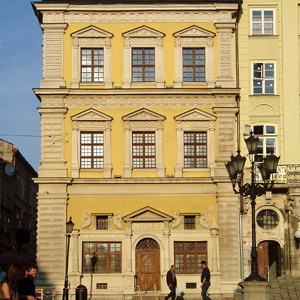
Palazzo Bandinelli is a monument of Renaissance architecture in Lviv of the late 16th – 17th centuries. The architect is unknown. The name comes from the surname of the house owner of the second quarter of the 17th century, Roberto Bandinelli. The monument is located at the corner of the east side of Rynok Square and Stavropigiyska Street.
In general, the house retained the planning structure and partially the interior of the 17th century. Authentic carved ceiling beams, white-stone pillars between the windows, encrusted with alabaster, have been preserved on the first floor in the front hall. The building has undergone numerous alterations during the 18th and 19th century. It got its modern look after a thorough restoration in 2000 – 2007.
Many important and interesting events in Lviv's history are associated with the names of owners and residents of Palazzo Bandinelli. In the early 17th century, Johann Alnpeck, author of 'Descriptions of Prominent Cities of the World' (Cologne, 1617) lived here. In 1629, Roberto Bandinelli opened the first regular post office in Lviv. In the 19th century there was a bookshop and Wildes’ book publishing firm. Since 2005, the building houses Lviv Historical Museum.
After visiting the museum, you will be able to see Bandinelli's house and its cellars. Interesting fact is, that the last room of the museum is a basement under the sidewalk. Only in Lviv there are basements beneath the sidewalk.
Monuments of jewelery at museum treasures
The exhibition 'Monuments of jewelery at museum treasures' is based on the materials from the fund of precious metals of Lviv Historical Museum. Some items were provided for exhibition by Lviv Art Gallery, Lviv Museum of Religion, Museum of Ethnography and Crafts of Academy of Sciences in Ukraine in Lviv.
The exhibition includes objects of artistic silver for applied, ceremonial and particularly sacred purposes. Chronological framework for the origin of the collection objects covers the interval from the end of the 16th century to the early 20th century – extremely interesting, eventful period in the history of Lviv and Galicia. Geography of the origin of museum items near Lviv covers important centers of jewelry in Austria, Poland, Russia, Germany, namely those countries with which our land was united by close trade and cultural ties, and partly by common historical destiny.
In the first part of the exhibition the Museum visitors can have a look at the complex of units which have not only artistic but also a significant historical value. They are related to important events in the history of Lviv, with life and work of prominent city citizens. Among significant items in this section there are the items of Lviv goldsmiths: seal of Lviv goldsmiths’ workshop (appr. 1600), symbolic keys of the city (18th century), Ceremonial chain of Lviv Presidents (1892), silver model of the City Town Hall (1920-1930).
The second part of the exhibition represents antique wares of European artistic silver, which come from the Lviv private collections, late 19th – early 20th century, including the collection of famous Lviv antiquary, historian and writer V. Lozynsky (1843 – 1913). In general, the exhibition represents about 150 items of silver art. The exhibition is complemented with thematic works of graphic and paintings.
Glass Museum
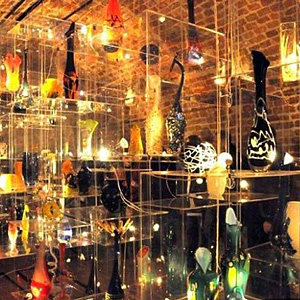
This museum is unqiue: it is the first and only glass museum in Ukraine. The first room of the museum displays historical works of glass. Glass, that is either manufactured in Western Ukraine or in this very region and ancient glass vessels and beads that were made in the Roman colonies in the south of modern Ukraine during 1-2 century BC. In the Glass Museum you can also see dishes (Viva bowls) from which wealthy nobles drank during the 17th and 18th century.
Glass art of the twentieth century (articles from Lviv Stry)
The second part of the museum is devoted to the modern period and to the collection of the International Symposium of Art Glass. This symposium, taking place in Lviv, started in 1989, and is held every three years. Over 200 artists from 29 countries attended the symposium. The exhibition shows works of artists from France, Japan, Hungary, UK, USA, Ukraine, Poland, Lithuania, Latvia, Estonia, Slovakia, Russia, Belarus, Portugal, Spain, Australia, Austria, Germany and Finland.
2 Rynok Square (entrance from Stavropihiyska Str.)
Tel. numbers: +38 093 729 20 82, +38 032 297 53 67
info@glassmuseuminlviv.org
www.glassmuseuminlviv.org
www.lhm.lviv.ua
Opening hours: every day from 10:00 to 18:00
Department of History of Ukrainian Diaspora

The first major wave of immigration was in from 1891 until 1920. Mainly Galician peasantry started to immigrate. Photos and documents, clothing and household items used by the first settlers, expand the idea of the first steps of Galician peasants. The second wave of emigration (1920-1939) covered Ukrainian political, scientific and artistic elite. In this section we focus on specific aspects of Ukrainian political leaders and Ukrainian scientific institutions actions. Among the exhibits covering this topic particularly interesting are original letters of the President of the West Ukrainian People’s Republic (WUPR) E. Petrushevych, passport of WUPR period, diploma from Charles University (Prague). The exhibition is finished with the number of documents, photographs and printed materials that shows life and work of the Ukrainian people in the camps of DP (displaced persons).
More widely and variously is represented the third (post-war) wave of emigration. Numerous museum exhibits introduces the visitors to the different genres of painting and literature, to the work of scientific, religious and civic organizations. The exhibition represents the works by famous painters: E. Kozak, A. Synytar, P. Lopata, Ya. Krehovetsky, A. Babych, Yu. Skorupskyetc. Literature is represented by the works of Ye. Malanyuk, T. Osmachka, Yu. Klen, E. Kozak, I. Kachurovsky, B. Oleksandriv.
Spiritual life of Ukrainian Diaspora can be traced through the prism of correspondence of Cardinal Josyf Slipyj. A striking addition to the theme is the clothes of the priest I. Shevtsiv from Australia, in which the priest, along with John Paul II celebrated the Mass in Lviv in 2001.
Among the museum exhibits covering social work, special attention is paid to the reconstruction of Ukrainian women’s clothing from the Kyiv Rus period (9th century) to the Hetman one (18th century), made in New York by a group Union of Ukrainian Women and also to the elements of uniforms of Ukrainian youth organizations in America ‘Plast’ and SUM (Union of Ukrainian Youth).
Items collected in the exposure helps to understand better that the Ukrainians living outside Ukraine is an important branch of the Ukrainian nation which enriches the treasury of our shared history, science, culture and art.
Department of Western Ukraine Lands
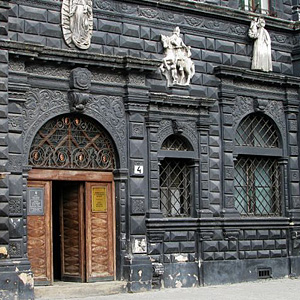
The third floor of the Black House holds the exposition of the Department of Western Ukraine Lands in the 2nd half of the 19th and the 20th century, which opened in January 1995. In the exhibition hall items from the period 1914-1941 are displayed. The theme of the exhibition is the struggle for realizing national ideas throughout Ukrainian history. Many museum exhibits show battles of the USS Legion (Ukrainian Sich Riflemen) – Ukrainian military formation during the World War II. Photos and documents, weapons of riflemen, pictures of O. Kurylas and L. Medvid add to the emotional experience.
A significant place in the museum is devoted to exhibits related to the national liberation revolution in Ukraine during 1917-1921; specimens of contemporary weapons, reconstructions of military uniforms of UGA and UNR Army, battle tachanka, documents and banknotes of UNR.
A separate exposition shows socio-political processes during the 1920-30s. Examples of items are: documents of political parties and associations, honors of the associations ‘Prosvita’ and ‘Ridna Shkola’, rare books, sheet music of works by Ukrainian composers, theater clothing of Ukrainian stage luminaries and examples of Lviv products.
Also, German and Polish weapons are displayed, reflecting the tragic events of 1939-1941 in western Ukraine. Photographs and documents are evidences of the repressive policy of the Bolshevik regime. The exhibition art design reflects the streets of Lviv, making showcases look like old Lviv gates and podiums like city cobblestones.
The exhibits help the visitors not only to understand the historical processes that took place at Western Ukrainian lands during the interbellum, but also to understand the value of national and liberation movements on the other territories of Ukraine, from Lviv's point of view.
4 Rynok Square, The Black House
Tel. number: +38 (032) 297 53 67
www.lhm.lviv.ua
Department of Historical Treasures 'Royal Halls'
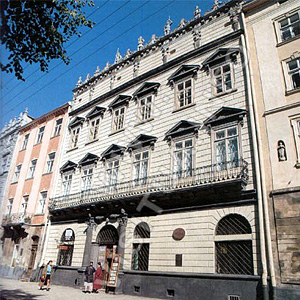
The exhibition of ‘Historical Treasures’ Department at Lviv Historical Museum is located in so-called ‘Royal Halls’ of Korniakt House – monument to the Renaissance architecture from the 16th century. During the 2nd half of the 17th century, the Korniakt House was used as one of the residences of the King of Rzecz Pospolita of Jan III Sobieski. Four former (representative) halls of the house, located on the 1st floor, are traditionally called 'Royal'. No one remains indifferent to the magnificent rooms interior, decorated in the style of late classicism, that emerged during the early 19th century. The floor is inlaid with 14 types of wood, exquisite stucco molding. The walls are pasted with artificial marble. Ancient mirrors in gilt frames hang silently on the walls. There is a beautiful marble fireplace, and crystal and bronze chandeliers hang from the ceiling.
Interiors of the halls are harmoniously complemented with unique exhibits from the 16th – 19th centuries from the fund collections of the museum: furniture, paintings, sculptures, clocks, musical instruments, porcelain, orders from various European and other foreign countries. A scala of magnificent pieces will demand no less than sheer admiration: gala portraits of crowned aristocrats, old furniture, a lady’s secretaire, inlaid with ivory and a gentleman’s secretaire with many drawers, a musical instrument of Mozart époque – a pianoforte, a round table with a surface set out in different types of stone, a mysterious black chair shaped as a winged dragon, the Order of the Golden Fleece – a masterpiece of Austrian jewelers and unique pocket sundials and sidereal clocks from the late 16th–early 18th centuries, etc.
The exhibition ends with listening to the music box ‘Symphonion’ (late 19th century). Everything will make an unforgettable impression and fuels the desire to visit the exhibition again and again…
6 Rynok Square, 2nd floor, Korniakt House
Tel. number: +38 032 235-69-90
www.lhm.lviv.ua
Department of Ancient History and Archeology
Archaeology
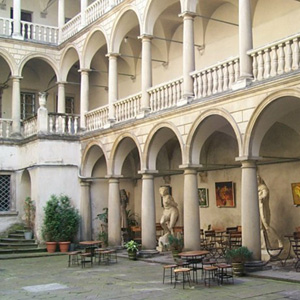
The exposition of the archeology department narrates the history of our country, beginning at ancient times up to the 9th century. Here one can see stone lithic flakes that were used 500,000 years ago, a musical pipe used for cult rituals 20.000 years ago and 7,000 year old tableware and more.
Many interesting artifacts of the Neolithic Trypillian civilization are displayed. Archaeologists see the roots of Ukraine in this culture. Painted trypillian zoomorphic and anthropomorphic ceramics, like the female statuettes ‘Oranta’ and ‘Madonna and child’ are beautiful examples of this age. Ritual ‘bread’ that resembles the fabulous Ukrainian ‘kolobok’, a vessel in the shape of a bullock harness, a trinocl, a symbol of a family (father, mother and the child); all unique items of cultures of the Old World.
You can see bronze artifacts from the village of Hrushivka (Ivano-Frankivsk region): proof of local foundry manufacture development during the Bronze Age. The galvanic copies of high art standard tell about the greatest golden treasure of the Eastern Europe, that weighs 7.5 kg and was found at Myhalkiv village (Ternopil region) in 1878. The treasure has been dated back to the 7th century BC and belonged to the tribe’s elite representative.
Your attention will be caught by the Vysotska Culture (10th-8th century BC): ceramics in different shapes, rare ritual twin and tee, figurines of birds. Also an interesting artifact is a child’s toy, a ‘torohcalce’.
The Scythians had a great influence on Ukrainian history. You will be fascinated by women’s adornments, by decorations of horse trappings, by the akinakt sword and by the Scythian bronze mirrors, which Scythian women would use to admire their own beauty.
A feast to the eye is the colored glass goblet, produced by a Roman craftsman in the 4th century. It was found in Nyzhniy Stryten (Ivano-Frankivsk region), which proves that local inhabitants traded with the Roman province at the Danube river.
The exposition finishes with pieces from the Slavs of the 6th-8th century. At that time the East Slavs lived in Volyn and Upper Podnistrovia, united in the Dulib tribe union, which together with the union of Middle Podniprovia formed the basis for the first Ukrainian state – Kyiv Rus.
Ancient History
The exhibition begins with Galicia-Volhynian State period (12th and 13th century). Here are archaeological finds from the cities of Galych, Zvenygorod, Terebovlya and others. You can see a collection of crosses; Engolpions from the 12th and 13th century, a ‘hrestylnytsyas’-fragment from the Assumption Cathedral in Galicia, where Galician prince Volodymyrko (father of Galician prince Yaroslav Osmomysl) was baptized and ceramic tiles (12th century) of the Assumption Cathedral in Galych.
The exhibition shows pieces, that reveal the history of Prince Lev and medieval Lviv: a buste of King Danylo by sculptor Theodosia Bryzh, a portrait of Prince Lev by L. Dolinsky, a panorama of 18th century Lviv by Z. Rozwadowski and Jurij Janowski (1928), artifacts of city self-government (Rada and Lava), which came from the old Lviv Town Hall, Lviv’s adviser’s scepters from the 18th century, a ceremonial sword from 1577 that symbolized the right of the City Court to sentence someone to death and an executioner’s swords from the 16th century. Unique is the vane from the 17th century in the form of a lion (the symbol of a town), coat of arms of Lviv and a model of the Town Hall from the 17th century.
Numerous exhibits reflect life in Lviv during the 17th and 18th century. These are products of casters (guns, bells, lanterns, and candlestick), tinsmiths (reflectors, bowls and hot water bottles), swordsman, locksmiths, and watchmakers. A table clock from the 18th centurt will without anty doubt get your attention. It shows not only the hours, but also the seasons, lunar phases and the days of the week.
Discoveries of archaeological sites helped to recreate scenes from the Cossack period: articles from a Cossack household in the 16th and 17th century, attributes of the Hetman’s power, Cossack arms and portraits of Cossack hetmans. Many mysteries are kept by a portrait of a young Roksolana (16th century): Nastya Lisovska from Rohatyn, a Turkish captive who became the wife of Sultan Suleiman II.
Extremely valuable is a collection of manuscripts and ancient books: gospels from the 15th and 16th century, Apostles, missals, menaions from the 15th and 18th century, a music book with church songs from the 17th century (28 kg, 41×62 cm), written on parchment and colorful illustrated and the first printed books in Ukraine: Lviv Apostle from 1574 and Ostrog Bible from 1581 by John Fedorovych.
Also of great value are the paintings: the portrait of Varvara Lange (M. Petrahnovych, 17th century), coffin portraits of Lviv Stauropegic Brotherhood members (from the Assumption Church in Lviv, 18th century) and the folk painting ‘Cossack Mamay’ (18th century) are exhibited.
Music played (yes, played) an important role in the life of Ukrainians. You can have a look at musical instruments from the 17th and 18th century: torban, lyre, pipe, trembita and organ.
Numerous items cover the life of different people; farmers, townspeople and magnates. The exhibition includes everyday objects that are true pieces of folk art; bourgeois furniture from the 18th century, exquisite magnate men and women dresses, Venetian mirrors and expensive hunting, silver and porcelain wares.
24, Rynok Square
Tel. number: +38 032 235 68 74
www.lhm.lviv.ua
The Gunpowder Tower
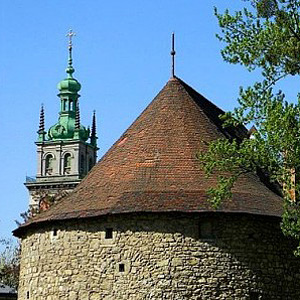
Out of several dozen of solid defensive towers, gates and bastions in Lviv, only one has survived until the present day – the Gunpowder Tower, built in 1554-1556 (4 Pidvalna Street). It was built of stones left over from the old City Arsenal. This was the strongest of the towers, since invaders would approach the city from that direction, from the east. The tower stands on defensive ramparts. Two hundred years ago, a park was laid out here, called ‘the Governor’s Ramparts’ after the residence of the Austrian Governor of Galicia (‘Halychyna’), which was nearby.
The Gunpowder Tower was not used exclusively for defensive purposes. Lviv was a trading centre, and so everything was designed to contribute to trade. During short intervals of peace, without the looming threat of enemies, the tower was used for storing grain. Since the late 1950s the tower has accommodated the so-called ‘House of the Architect’, which often hosts cultural events. Even though the tower looks quite vast from the outside, the inside facilities are rather confined, because the walls are three meters thick. The tower entrance is guarded by two white marble lions of the 19th century, which, from among the approximately seven thousand stone lions in Lviv, are of the greatest artistic value.
Memorial Museum of Composer and Pedagogue Stanislav Ludkevych

This museum was opened as a branch of the Solomiya Krushelnytska Museum in 1996. The maestro’s widow Zenoviya Shtunder donated the house and the archive of this prominent composer, musicologist and pedagogue with the purpose of opening a museum.
The museum’s special feature is the fully preserved interior of the house. There is a memorial plate on the building’s facade honouring the composer (authors – Vasyl and Volodymyr Odrekhivsky).
7 Ludkevycha Street
Tel. number: +38 032 276-96-12
muzejsk@ukr.net
www.salomeamuseum.lviv.ua
Opening hours: daily except Tuesdays
Museum of Ancient Ukrainian Books

This separate department of the Lviv Art Gallery is also a research centre. The collection of ancient and rare Ukrainian books totals 12,000 pieces, such as manuscripts and old printed editions, books on Ukrainian culture, history, book illustrations, ex-libris samples, and pedagogical literature from the 19th and 20th century. In 1978, the museum instituted the Fedorovsky Seminar, an international scientific conference on the history of manuscripts and ancient books.
15a Kopernyka Street
Tel. numbers: +38 032 272 25 36, +38 032 261 30 12
Opening hours: 10.00 – 18.00, Tue – Sun
Museum of Ethnography and Arts and Crafts
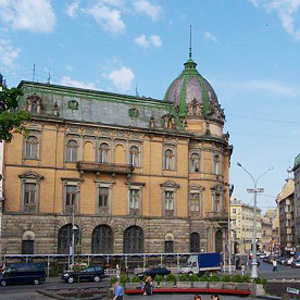
This is the oldest museum in Ukraine. It presents a unique and remarkable collection of traditional artifacts of national culture, folk art and crafts of the Ukrainian people. The museum opened its doors in 1951, when two of the greatest museums in Lviv decided to unite their efforts and premises: the Municipal Museum of Industry (founded in 1874), and the Museum of the Taras Shevchenko Scientific Society (1895).
The collections -over 83,000 items- are displayed in 17 different exhibits. The main exhibition hall is located on the premises of the former Galician Savings Bank. Here, you can see cultural, spiritual items, items of Ukrainian everyday life and national arts and crafts from the 19th and 20th century.
The museum also organizes a number of temporary exhibitions. The exhibition halls are divided into two distinct sections: ethnographic (over 44,000 pieces) and arts and crafts (over 28,000 pieces).
15 Svobody Avenue
Tel. number: +38 032 297 01 57
mehp@ethnolog.lviv.ua
Opening hours: 11.00 – 17.00, Wed – Sun
Museum of General-Lieutenant of the UIA Roman Shukhevych
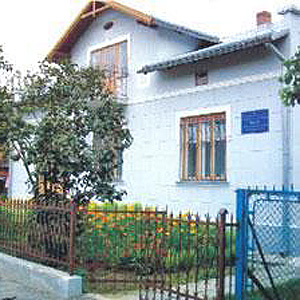
This museum was founded with help and financial support of the ‘Association of Former Soldiers of the UIA of General-Lieutenant Taras Chuprynka in the USA’. The museum was opened on October 23, 2001. The building has two floors. On the ground floor there is a thematic exhibition, the first floor includes a memorial exhibition. Exhibits located on the ground floor, tell about the Shukhevych family, youth of Roman Shukhevych, his military and political activities and the armed struggle of the Ukrainian liberation movement.
In the first hall there is a bust of Roman Shukhevych, created by famous Ukrainian sculptor Mykhailo Chereshniovsky (1911 – 1994), made by the artist in the U.S. during the 1980s. It was donated to the 'Association of Former Soldiers of the UIA in the USA', which gave the bust to the museum. Paintings by Myroslava Lasovska-Kruk (USA) – portrait of Roman Shukhevych and allegorical arrangement 'Heroine of UIA', also contribute to perpetuation of Roman Shukhevych’s memory.
A separate room is dedicated to the birth of the UIA, its formation and the role of Roman Shukhevych in its activities. The section concludes with a set of materials on the heroic death of Roman Shukhevych on March 5, 1950. Materials about the fate of Roman Shukhevych’s family, all the representatives of which suffered from the repressive and punitive system, constitute an important part of the exposition.
The first floor exposition (stairs, hide-out, living room) recreates the life during the stay of the UIA Commander in Chief at this underground apartment (spring 1948 – early 1950’s) and is the main memorial object of the museum, as the last battle of Roman Shukhevych with the division of MGB took place there on March 5, 1950. In the same room where Shukhevych lived and worked are the original pieces; a table with four chairs and a armchair made in the mid 1930s in Western Europe, which were presented to the museum by daughter of Roman Shukhevych, Mrs. Maria Trylovska.
76a Bilohorshcha Street
Tel. number: +38 032 272 70 60
Department at Lviv Historical Museum
Museum Lychakivsky Tsvyntar (Lychakiv Cemetery)
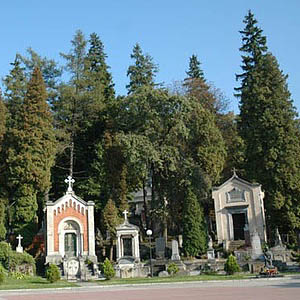
The cemetery has been classified as a historic and cultural museum and heritage preserve. It occupies an area of 40 hectares. It was officially founded in 1786 by the new Austrian government in Lemberg (Lviv), the capital of the Austro-Hungarian Kingdom of Galicia and Lodomeria. The oldest tombstone in the cemetery dates back to 1675. The Lychakiv Cemetery is also famous for some 23 beautifully adorned chapels and shrines, which belonged to wealthy Lviv families. The latest popular tourist attraction in Ukraine (and in Europe) proposes excursions by night in the Lychakiv Cemetery.
33 Mechnikova Street
Tel. number: +38 032 275 54 15
lviv-lychakiv@ukrain.travel
www.lviv-lychakiv.ukrain.travel
Opening hours: 9.00 – 18.00, Mon – Sun
Shevchenkivsky Hay
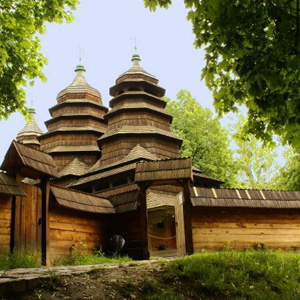
Lviv Museum of Folk Architecture and Rural Life is an open-air museum containing over 120 monuments of folk architecture, including chapels, belfries and six wooden churches. The park-museum is located on 50-hectare of land in Shevchenkivsky Hay (Shevchenko Park). Unbelievably beautiful wooden houses and churches of past ages create a genuine atmosphere of Ukrainian villages from different regions of the country; Boykos, Lemkos, Hutsuls, as well as Bukovyna and the Transcarpathian Region. In dwelling and utility houses you will find items of everyday life and farm tools. Four exhibit rooms are also open to the public. Two of these rooms display permanent exhibitions.
The oldest monument in the open-air museum is a house from the Carpathian village of Lybokhora, dating back to 1749. The exposition includes wooden churches from the village of Kryvka (1763) of Turka District and the village of Tysovets (1863) of Skole District, remarkable for their unique shape. The church from Kryvka is a folk architecture masterpiece of European importance.
Folklore-ethnographic ensembles stage their performances on the museum’s territory. The annual folklore festival called 'From the Folk Source' (Z Narodnoyi Krynytsi) enjoys great popularity among the visitors. Liturgies are performed at churches and especially impressive are the divine services at the Lord’s Wisdom Church (the church from the village of Kryvka) held at Christmas and Easter.
The task of the museum is to collect, study and widely display typical features of rural architecture of the Western Ukraine. It shows and explains the life and traditions of various strata of the Ukrainian population, from the end of the 18th century to the beginning of the 20th century.
The Museum is divided into 8 exposition areas: 'Boikivshchyna', 'Lemkivshchyna', 'Gutsulshchyna', 'Bukovyna', 'Podillya', 'Polissya', 'Lvivshchyna' and 'Volyn', which represent the ethnographical and historical zones of Western Ukraine.
1 Chernecha Gora Street
Tel. numbers: +38 032 243 78 23, +38 032 247 18 82
museumlviv@gmail.com
www.skansen.lviv.ua
Opening hours: 9.00 – 18.00, Mon – Sun
Museum of Old Monuments of Lviv
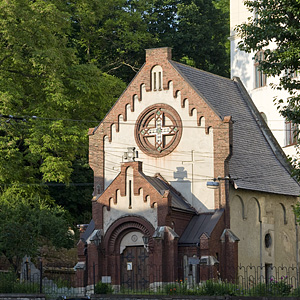
The museum’s exposition is dedicated to works of art, sacral relics, historical documents and archaeological finds. The museum is located in John the Baptist Church. The history of this church’s foundation is surrounded with legends about the founder of Lviv, Prince Lev, and his wife, Hungarian princess Constance. Individual architectural elements of the church date back to the 13th century and testify to the building skill of old Ukrainian architects. The church was rebuilt several times. The modern stylized reconstruction in Neo-Gothic style was created by architect Yuriy Zakharovych in 1887. The exposition of the Museum of Old Monuments includes one of the oldest icons created in Western Ukrainian lands which has survived to this day: ‘The Virgin Mary with the Child’ (second half of the 14th century), as well as a sculpture from the same period: the statue of ‘The Suffering Christ’.
1 Uzhhorodska Street
Tel. number: +38 032 272 28 86
Opening hours: 10 a.m. to 5 p.m. daily except Mondays
Museum of Johann George Pinsel
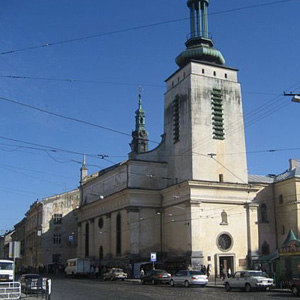
The Museum of Sacral Baroque Sculpture (The Museum of Johann George Pinsel). The museum’s exposition consists of 32 exhibits representing art of European and global level. The museum is located in the former Poor Clares Cathedral designed by Paolo the Roman and built in 1605-1607. The frescoes of the cathedral were created in 1670. The works of prominent Lviv sculptor Johann George Pinsel exhibited in the museum, constitute a remarkable phenomenon in the history. Under the influence of Eastern Byzantine art the master, who was of European origin and education, created an original heritage second to none in 17th-century Europe. He founded Lviv School of Baroque Sculpture, where about forty masters underwent his instructions.
In the late 1750s Pinsel created the sculptural ensemble in St. George Cathedral and also worked in St. Martin Cathedral and in the town of Monastyrska in the Ternopil region. The brightest of Pinsel’s works in terms of emotional influence is the altar from the cathedral of Hodovytsa village near Lviv, sculptures ‘Abraham’s Sacrifice’ and ‘Samson’.
2 Mytna Square
Tel. number: +38 032 275 69 66
Opening hours: 11 a.m. to 4 p.m. daily except Mondays
Mykhaylo Hrushevsky State Memorial Museum
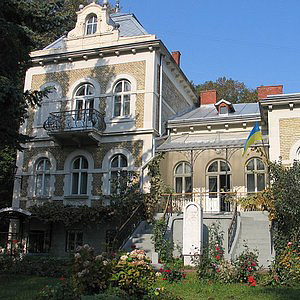
The museum is a modern historical and cultural institution with a large collection of relics that tell the story of life, creativity and political work of the scientist and first President of Ukraine, Mykhaylo Hrushevsky. The museum’s six exhibition halls characterize virtually all periods of his life and his colossal work, but special emphasis is placed on his Lviv period (1894-1914). This is quite understandable, since the two most fruitful decades were spent Lviv. During this period Hrushevsky showed his scientific talent as founder and organizer of many Ukrainian institutions (Taras Shevchenko Scientific Society, The Literary and Scientific Herald, The Notes of Shevchenko Scientific Society), as a scientist, historical researcher, literary critic and as professor of Lviv University. He was also author of fundamental works as ‘The History of Ukraine-Ruthenia’ and ‘The History of the Ukrainian Literature’, and did substantial research on the history of Ukraine, literature, ethnography, folklore and sociology, that has been highly recognized by scientists throughout the world. And that deserves some special attention.
The pride of the collection are original editions of Mykhaylo Hrushevsky, his photographs and letters, personal belongings, periodicals and a set of authentic documents. The garden, planted by nine European presidents during the Summit of Heads of Eastern and Central European States in Lviv in May 1999, blossoms on the museum’s territory.
154 Franka Street
Tel. number: +38 032 276 78 52
National Zoological Museum of Franko Lviv National University
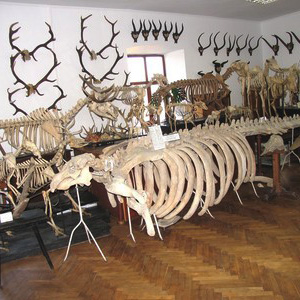
National Zoological Museum of Franko Lviv National University is one of the oldest university museums in Europe. Established, as the Cabinet of Natural History in 1784. With the advent of Lviv University professor Benedict Dybowski, it got the status of Zoological Museum. February 25, 1885 by the order of the rector to create a museum for the Cabinet, three rooms and a corridor were appointed. Thus, the museum received five rooms with a total area of 470 m2 at its disposal, which until now show fauna from all over the world to students, biologists and numerous visitors. Today, the museum has more than 178 thousand items, 10 thousand of which form the exposition. The museum has preserved more than 130 types of animal specimens, that were first discovered and described by science. The museum collection represents all the continents and many waters of the globe. Zoological Museum does guided tours for both students, staff of the University but also to other visitors.
4 Hrushevskoho Street
Oleksa Novakivsky Artistic and Memorial Museum
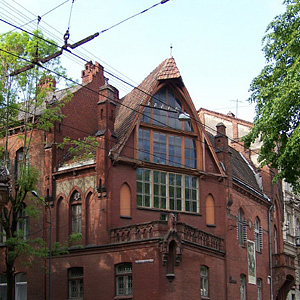
Oleksa Novakivsky Artistic and Memorial Museum of is a permanent exposition representing the creative career of this outstanding Ukrainian artist. In 1911 the museum’s building was purchased by Metropolitan Andrey Sheptytsky who handed it over to the National Museum two years later to serve the needs of Ukrainian artists. This is how the building became the place of residence and the creative workshop of Oleksa Novakivsky. In 1923-1935 it housed Novakivsky Art School – the first institution of art education in Western Ukrainian lands.
After the artist’s death the house changed hands several times. Until 1971 it was home to the workshop of prominent sculptor Ivan Severa. In spring of 1972 Oleksa Novakivsky Artistic and Memorial Museum was opened in the building on the artist’s 100th anniversary, celebrated ceremonially by UNESCO.
11 Lystopadovoho Chynu Street
Tel. number: +38 032 261 05 52
Olena Kulchytska Artistic and Memorial Museum
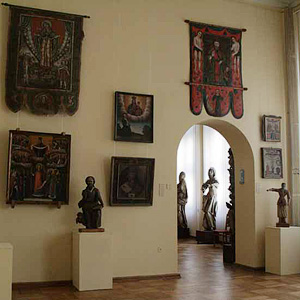
The exposition includes paintings and graphic works by the artist, decorative and applied works created according to her designs, as well as archival materials, photographic documents and memorial items. The museum was founded in 1971 in the four-room flat where the artist used to live. Olena Kulchytska’s workshop presents oil paintings of the early period (Vienna and Przemysl): portraits, landscapes, works on domestic topics, compositions with a plot, decorative furniture made according to the master’s design, a small loom, and an engraving press.
The museum’s exposition also includes graphic works, embroideries, and works on religious topics: tapestry ‘The Virgin Mary with the Angels’ (1910), oil paintings, colour linoryt, and a ceramic dinner set.
9 Lystopadovoho Chynu Street
Tel. number: +38 032 261 07 06
Pharmacy Museum ‘Under the Black Eagle’
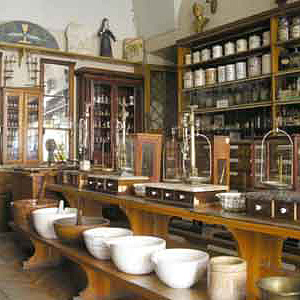
Museum Pharmacy ‘Pid Chornym Orlom’ (Beneath the Black Eagle) was founded in 1735. A museum related to pharmaceutical history was opened on the premises of the old pharmacy in 1966. The idea of creating such a museum had already come up in the 19th century. The Galician Association of Pharmacists was created in 1868; members managed to assemble a small collection of exhibits, thus making the first step towards creating a new museum. Nowadays, the exhibition has expanded considerably, with 16 exhibit rooms and a general exhibition, with a surface totalling 700 m2. There are more than 3,000 exhibits in the museum.
This is the only operating Museum Pharmacy in Ukraine and Europe. Just beside the unique pharmacy, you can visit the museum itself, which presents rare and curious exhibits, assembled by scientists, pharmacists, and enthusiastic collectors. Today, the pharmacy operates daily; here, you can still buy all your required medicine, as well as the renowned «Zalizne Vyno» (Iron Wine).
2 Drukarska Street
Tel. numbers: +38 032 272 00 41, +38 032 235 70 41
www.apteka.iatp.org.ua
Opening hours: Mon-Fri 9.00 – 18.00, Sat-Sun 10.00 – 17.00
Prison at Lontskoho Street Memorial Museum
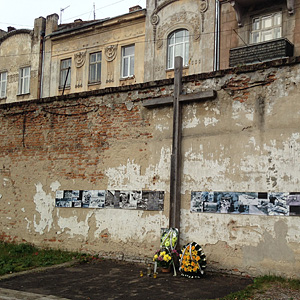
Memorial Museum Dedicated to Victims of Occupational Regimes: ‘Tyiurma na Lontskoho’ (Prison at Lontskoho Street) can be found on the premises of a prison, where punishments were meted out by three occupational powers: Poland, the Soviet Union, and Germany. The first memorial exhibit is situated on the first floor of the building, where the authentic appearance and conditions of the prison have been preserved; in fact, it has not undergone any major changes since it was occupied by political prisoners.
The exhibition was prepared by employees of the Research Centre for the Liberation Movement, and supported by the Security Services of Ukraine. Donations from Lviv citizens and other visitors are accepted to cover costs of the memorial opening and upkeep.
1 Stepan Bandera Street
Tel. number: +38 032 247 42 20
memorial@lonckoho.lviv.ua
www.lonckoho.lviv.ua
Opening hours 9.00 – 19.00, Mon – Sun
Rusalka Dnistrova Museum
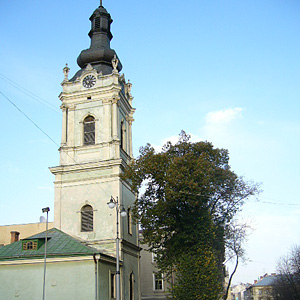
Rusalka Dnistrova Museum tells us about the history of the most remarkable book of the Ukrainians of Halychyna and the activities of the Ruthenian Trinity public and cultural group. The museum’s exposition is located in the belfry of the Holy Spirit Church – a Baroque monument of the 18th century. The unique clock seen on the belfry’s tower was installed in the 17th century at Manyava Monastery by Hetman Ivan Vyhovsky and brought to Lviv in the late 18th century. The clock’s operation was restored in 2000s. In 1783 the Holy Spirit Church was handed over to the Greek Catholic Theological Seminary. Prominent activists of Ukrainian culture, members of the Ruthenian Trinity Markyian Shashkevych, Ivan Vahylevych, and Yakiv Holovatsky studied at this seminary. The museum’s exhibits follow the history of research, literary, journalistic and publishing activities of the Ruthenian Trinity. The exposition presents documents that cover the publication history of ‘Rusalka Dnistrova’ – the first almanac of Halychyna printed in Pest in 1837 – in great detail.
40 Kopernika Street
Tel. number: +38 032 298-74-82
Opening hours: 11 a.m. to 4 p.m. daily except Mondays and Tuesdays
Solomiya Kryshelnytska Musical Memorial Museum
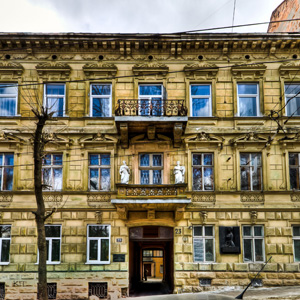
The Solomiya Krushelnytska Musical Memorial Museum is located in the former home of the renowned singer.
The exhibit rooms display original photos, posters, concert programs, portraits, some stage costumes, music scores, and personal items. An excursion through the rooms of the museum takes you back into the past. As you enter the artistic world of Solomiya Krushelnytska, you walk with her along the path of her life; you wonder and rejoice at her successful performances in the most prestigious theatres of the world; you meet her friends and family and get to know them better. And, in the end, you can hear the unique voice of this Remarkable Singer.
Exhibit rooms: The White Room: Childhood and Youth; Artistic Rooms: Krushelnytska in Wagner’s Operas, From Halka to Madame Butterfly; At the Height of Fame; The Last Years of Solomiya Krushelnytska’s Life.
23 Solomiya Krushelnytska Street
Tel. number: +38 032 261 04 76
muzejsk@ukr.ne
www.salomeamuseum.lviv.ua
Opening hours: 10.00 – 17.00, Tue – Sun
Galeries
Gallery-Café ‘Shtuka’
Gallery-Café ‘Shtuka’ (Handiwork) opened in April of 2009. The café recreates the artistic atmosphere of the Austro-Hungarian period in Lviv. The café organizes exhibitions of paintings and photographs of modern-day artists; exhibitions rotate every month. Often, the café also organizes evenings of the most socially-attractive dance of our times: the Argentine tango.
8 Kotljars’ka Street
kawiarnia.sztuka@gmail.com
www.shtuka.net.ua
Opening hours: 09.00 – 22.00
Lviv Art Gallery
Lviv Art Gallery is the largest art museum in Ukraine (approximately 50 thousand exhibits), with a collection of unique paintings, sculptures and works of graphic art of Western and Eastern Europe, from the Middle Ages to modern days.
The German paintings are represented by one of the finest examples of the Late Gothic style: an image of three saints (Mary Magdalene, Odilia and Clare) painted by an unknown master in the late 15th century. The achievements of German portraiture are shown by paintings, created by the best artists of the genre in Europe of the second half of the 18th century. Lviv Gallery can also boast one of the largest collections of Austrian art of Baroque era in Europe.
The painting ‘At the Moneylender’s’ by Georges de La Tour is a pearl among the outstanding artistic valuables of the gallery. This painting, created by the most mysterious master in the history of European art, is the only one in Ukraine and one of the few surviving in the entire world.
French, Dutch, Flemish and Spanish paintings are also sufficiently represented in the gallery, while the collection of Polish art of the 16th-20th centuries is the best one in the world outside Poland. The exposition contains works by prominent Polish masters of the 19th century, including Artur Grottger and Jan Matejko.
The European art of the 20th century is represented by diverse works created by artists belonging to various schools and artistic trends.
3 Stefanyka Street
Tel. number: +38 032 261 46 15
http://lvivgallery.org
Opening hours: 11 a.m. to 5 p.m daily except Mondays
Dzyga
Terra dell’Arte of contemporary art for Ukrainian and not-Ukrainian artists. In this unique gallery you can enjoy viewing paintings, graphic art, sculptures, special installations, performances, happenings, icon painting, words, your own soul, energetics and charisma.
The «Dzyga» Gallery opened in 1997. Since then, more than 1.5 million creative participants, visitors and spectators have taken part in 394 exhibits, 117 performances and lots of other extraordinary events and attractions.
35 Virmens’ka Street
Tel. numbers: +38 032 297 56 12, +38 032 276 74 20
dzygainfo@gmail.com
www.dzyga.com
Opening hours: 10.00 – 24.00, Mon – Sun
Muzey Idey
This gallery was founded in 1993. It organizes artistic projects, exhibits, plein-air painting sessions, and symposiums. This is a place where the most diverse artistic and creative ideas and projects are born, grow and materialize. A great number of cultural and artistic projects have been created, developed and put into effect since the museum was opened. Some of the most well-known are:
- KinoLev. An international indie festival which takes place annually in Lviv.
- Lviv, Handicraft Capital. A festival presenting traditional artistic and creative handicrafts.
- Bernarden Garden. A territory dedicated to free plastic arts and ideas – a place for symposiums and plein-air sessions where the outstanding grandeur of Lviv’s historical centre serves as a backdrop for figurative and monumental art creations.
- SkloKoko (CocoGlass). International plein-air event with artists who work with glassblowing techniques and glassworks.
- LeoPoltvis. An international artistic project, aimed at saving the subterranean Lviv River, Poltva.
18a Valova Street
Tel. number: +38 032 295 69 68
idem.org@gmail.com
www.idem.org.ua
Opening hours: 10.00 – 20.00, Mon – Sun
Gallery of the History of Ukrainian Military Uniforms
This gallery presents certain reconstructions of Ukrainian military uniforms during the period of liberation movements in the first half of the XX century. The exhibits presented in the gallery, reflect the scientific work and research of many years by Bohuslav Lyubiv, Honoured Art Worker of Ukraine and member of the Society of Designers of Ukraine.
These unique exhibits reflect the historic origins, development and traditions of military formations in Ukraine during the first half of the XX century, and reproduce lost curiosities of military uniforms.
Pory Roku
The gallery organizes art exhibits, art projects, creative get-togethers, auctions, and so on. The gallery aims at popularizing artistic achievements and stimulating new creative talents among the instructors and students of the Lviv National Academy of Arts.
23 Virmens’ka Street
Tel. number: +38 032 272 15 69
academy@mail.lviv.ua
www.academy.lviv.ua
Opening hours: 11.00 – 16.00, Mon – Fri
Art-Gallery LvivArt
LvivАrt – a project that aims at popularizing works of art by Lviv artists. These works of art can be ordered directly on the Internet by accessing the Internet-Gallery of LvivArt.
21 Lesia Ukrayinka Street
Tel. number: +38 032 235 56 65
lvivart@lvivart.com
www.lvivart.com
Opening hours: 11.00 – 18.00, Tue – Sun
Аrt-Gallery Primus
The gallery opened on the 1st of April, 2009. It has taken part in two gallery fairs in Kyiv, and has attracted artists who render the Genius Loci (spirit of place) of many other towns or areas. The gallery takes part in the global art community.
Even though the gallery is located on Virmenska Street,the Mecca of Descriptive Artists, it has always adhered to and conducted its original artistic and creative policy.
There are many galleries located in the centre of Lviv. The ancient streets of the old city centre exude exotic charm and continue to draw artists like a magnet. Unfortunately, this could mean to both artists and gallery owners, that somewhat unconsciously, many of them could be influenced by of the surrounding 17th – 18th century streets and buildings, and this tends to limit certain expressions of individuality and creative fields of research.
The Primus Gallery is very conscious of this and strives to convey a different ideology.
16/5 Lesia Ukrayinka Street
Tel. number: +38 032 247 04 73
artprimus.lviv@gmail.com
www.primusart.com.ua
Opening hours: 11.00 – 19.00, Tue – Sun
Slyvka
Art Salon ‘Slyvka’ is a gallery of modern art, that opened in in 2006. Since then it occupied a niche in the artistic environment of the city. In the art salon are regulary held exhibitions of paintings by famous Lviv artists. Paintings, sculptures, glass, ceramics and exclusive handmade necklaces are exhibited. You can get expert help in forming collections, choosing gifts, selecting works of art for home and office.
24 Teatralna Street
Tel. nuber: +38 032 235 58 28
slyvkart@ukr.net
slyvkagallery.com
Herdan (Galician Ornament)
This gallery has been on the Ukrainian art market since 1995. Here, you can admire and purchase various works of modern art: paintings, graphic drawings, or ceramics. We also offer advice, and help our visitors to start up their own collections, purchase special gifts, or select specific works of art for homes or offices. Artists working in our gallery are prize winners or laureates of prestigious international art forums.
4 Ruska Street
Tel. number: +38 032 272 50 46, +38 032 297 10 01
Opening hours: 12.00 – 17.00, Tue – Sat
Gallery of Modern Art Zelena Kanapa
The gallery organizes exhibits and projects that usually last three weeks. The gallery has a history of conceptual personal and group exhibitions and projects. Free admission on weekdays; 2 UAH on Saturday and Sunday.
7 Virmenska Street
Tel. number: +38 032 235 75 49
zelena_kanapa@ukr.net
www.artgreensofa.com
The Palace of Arts
The National Publishers Forum and other cultural events are held at the Palace of Arts. The Palace of the Arts was opened in 1996 and is considered to be the largest exhibition hall in Ukraine. The exhibition surface totals 3,600 m2. The Palace also boasts a Conference Hall accommodating 200 visitors, and a large stage and art-reception area.
The Lviv Palace of Arts has hosted numerous exhibits of unknown artists representing different art movements, famous Ukrainian artists, and celebrated international creators.
The palace was designed by architect V. Kamenshchyk and engineer V. Kulykovsky and was built in 1996. The facades are decorated with classicistic arcade loggias. The loggia facing Kopernyka Street is decorated with a metal fence made by the Association of Blacksmiths in 1998, in the tradition of old Lviv crafts.
17 Kopernyka Street
http://www.artpalace.org.ua
Opening hours: 10.00 – 17.00, Tue – Sun
Iconart
Gallery of contemporary sacred art ‘IconArt’ aims to converge contemporary art and Christian spirituality. Starting point is the traditional concept of icons in the Eastern Christian tradition, as well as awareness of the role and place of culture in modern society. This art is designed to seek new forms of expression, experimenting with new materials, but draw inspiration primarily from the deep understanding of the truth of Christianity.
26 Virmenska Street
Tel. number: +38 032 235 52 95
www.iconart.com.ua
Gary Bowman art gallery
The purpose of the private Gary Bowman gallery, which opened in Lviv in 2009, is to promote creativity and originality in the way of thinking and in the manner of expression of individuals, whose work today ensures European fame for Lviv.
18 Nalyvayka Street
Tel. number: +38 095 899 51 74
garybowmangallery@gmail.com
Opening hours: 12.00 – 19.00, Tue – Sun
Pravda B Gallery
We reject fancy ‘artists’ and petty ‘masters’. We initiate and support courageous and interesting ideas, we collect and offer people the truth. We represent: humane clothes ‘Moksha’, miraculous ceramics from Opishnya, post-apocaliptic steam punk jewelry, myth paintings by T. Kyeby and many other interesting and unsurpassed things.
25 Virmenska Street
Shchos tsikave
An open air gallery, that makes it even more interesting and unusual for all the guests. You will enter the magic atmosphere of artistic entourage, which combines uncomparable things: fragility and brittleness of glass with audacity of wire, Lviv’s coffee flavor mixed with the smell of art materials, art-house movies and homemade biscuits.
13 Rynok Square
Tel. number: +38 063 239 32 24
office.prostir@gmail.com
Lemish
‘Lemish’ as an association gives the opportunity to create, develop and exhibit. The main directions of the association is Art: exhibition activities, galleries and art shops, concerts, meetings with interesting people and Art school: painting, making music and photography for adults and children.
7b Stavova Street
Tel. number: +38 050 177 52 30
Melanka gallery
Art Gallery of author decorations, works of contemporary jewelry and interior decorations. We show a collection of author decorations and paintings made in the hot enamel technique and other materials. Here you can find interesting original works. Gallery ‘Melanka’ aims to expand the boundaries of contemporary jewelery and its popularity.
6 Lesi Ukrainky Street
Tel. numbers: +38 032 235 48 26, +38 067 706 36 47
artmelanka@yahoo.com
(Source: http://lviv.travel/en - wikipedia)
VIDEOS OF LVIV
"Our Beautiful City"
"Little Paris (in english)"
Lviv from the air
Christmas in Lviv
Lviv Ukraine
BANDS AND SINGERS
Okean Elzy
Jamala
The Hardkiss
Tina Karol
Christina Solovy
Piccardysky Tertsiya
Ruslana
Skryabin
Alyosha
Olexander Ponomarev
Zlata Ognevich
Onuka
Antityla
Loboda
Irina Dumanskaya
Irina Fedishin
Vivienne Mort
Krykhitka Tsakhes
S.K.A.Y.
Druha Rika
Boombox
Buv'ye
Lama
Platch Yeremy
Voply Vidoplasova
T.N.M.K.
Tartak
Noomer 482
Braty Hadukyny
O. Torvald
Bahroma
Epolets
Haidamaky
TIK
Ani Lorak
